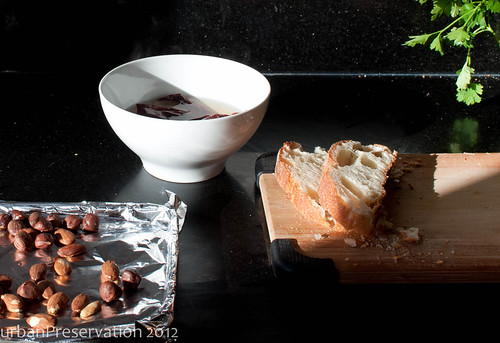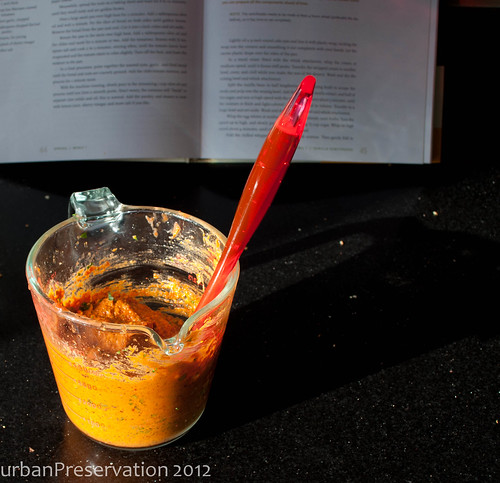
Don’t let this confession make you think that my cookbooks sit on the shelf gathering dust. I use them all the time just perhaps not for what most people do. I use about 5% of my cookbooks and the rest I just fish out the sauce-type recipes and make those over and over. By the time I get around to making a meal, I’m often too tired to go out and get any missing ingredients or learn a complicated new method. But by taking the sauce recipes and adding them to my already-tried techniques I could get a whole new dish with fewer complications. And I could arguably claim to be using my cookbooks and thus justify their ever growing number. Perfect.

This is how I fell in love with Romesco sauce, a recipe that came from one of my fanciest cookbooks and which is incredibly easy to make. It uses a lot of odds and ends – a few almonds and hazelnuts, the ends of a loaf of bread toasted golden, and that annoyingly small amount of canned tomatoes left from another experiment. And the end result is much, much more than the sum of its parts. It has a dark and earthy flavor from all the dried chilis and because it is doesn’t require emulsification it can be easily thinned out to create a marinade without creating an oily mess.

The recipe is pretty high in ingredients but don’t let that keep you from making it, especially since it’s mostly a toast-blend-and-serve kind of thing. It’s endlessly versatile – the original recipe it came from called for the sauce to be served on potatoes (an excellent choice) but I also spread it on bread, add it to hummus or yogurt sauce, use it to marinate meat or fish, scramble it into eggs, and drizzle it on roasted vegetables. A jar of it will keep in the fridge for up to three weeks but why wait that long? I find a well made sauce can perk up just about any meal and turn it from weeknight-standby to new-and-delicious, in about 3 tablespoons.

Romesco Sauce
Lightly adapted from Sunday Suppers at Lucques by Suzanne Goin
Makes 1-2 cups of sauce, depending on thickness.
5 dried ancho chiles – you can substitute New Mexico, pasilla, California/Anaheim, or guajillo chiles
2 tbs raw almonds
2 tbs raw hazelnuts
4 tbs plus 1 cup olive oil
1 slice white bread – any will do – about 1 inch thick
1/3 cup canned tomatoes
1 clove garlic, chopped
1 tbs chopped flat-leaf or Italian parsley
Juice of half a lemon
Salt to taste, about 2 tsp
Preheat oven or toaster oven to 375F. Spread nuts on a baking sheet and toast for 8-10 minutes until they are golden brown and aromatic.*
Remove and discard the stems and seeds of the chiles. Soak them in warm water for about 15 minutes to soften. Strain and pat dry.
Heat a large sauce pan on high heat with 2 tbs of olive oil. Fry the slice of bread on both sides until a deep golden brown. Remove and cut into one inch cubes.
Keep the pan on high heat and add 2 more tbs of olive oil to the pan and add the chiles and sauté until they blister slightly, about 5 minutes. Add the tomatoes and season with ½ tsp of salt. Cook until tomato juices have mostly evaporated. Turn off heat and let cool slightly.
In a food processor, blender, or with an immersion blender, pulse the toasted nuts, garlic, and bread until coarsely ground. Add the chile/tomato mixture, parsley, and lemon juice and process until smooth and well distributed.
With the motor running add olive oil, up to one cup until the sauce reaches your desired texture.** The sauce may separate into oils and solids – that is normal and it will mix back together with about a minute of blending. Taste to adjust seasoning. Refrigerate for up to three weeks.
*You can skip this step entirely and use roasted nuts instead. I like the extra toasty flavor but it doesn’t make a big difference.
** I prefer to add only ¼ cup of oil and keep it more like a paste because I find it’s easier to use that way. If I need it to be thinner for a marinade, I thin out only the amount I’m using.
No comments:
Post a Comment